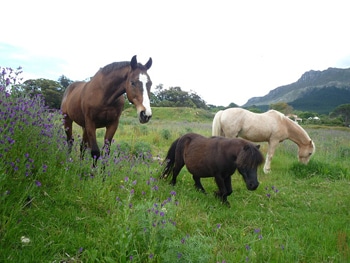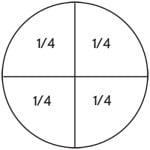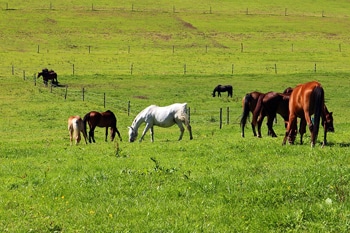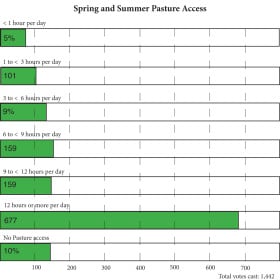Spring is here, and for some lucky horses this means spending time in a pasture eating grass. It is tempting to turn horses out into spring pastures at the first sight of green grass, especially after a long winter. However, spring grazing should be introduced slowly. How do you go about introducing horses to spring grass?
A good strategy is to wait until the grass in the pastures reach 6 to 8” (15 to 20 cm) in height. The first time out on grass should be just 15 minutes! Yes, that’s right, just 15 minutes.
1. What fraction of an hour is 15 minutes?
After the first day, increase the grazing time each day by 15 minutes until 4 to 5 hours of grazing time is reached.
Imagine you’re responsible for turning out the horses at a barn.
Spring has arrived and it’s time to schedule the horses’ transition from the winter time hay only diet to one that includes grazing.
2. How many days of turnout are required for the horses to be out for one hour?
3. After the first week, how many minutes will the horses be out on pasture?
4. How many hours will the horses be allowed to graze after 12 days?
5. How many days will it take to work up to 5 hours of grazing?
As well as the time restrictions, it is also a good practice to feed horses their normal hay diet before turning them out to pasture during the first several grazing days of the year. This will slow down their eating of the pasture grasses.

Why is it important to go slow when introducing horses to spring grass?
For one thing, green pastures are not natural to a horse! Think of horses in the wild, and the rangeland they graze over, it’s often pretty sparse, with horses walking miles each day to find enough to eat.
Another reason is that whenever a horse’s diet is changed, the change should be gradual. Turning a horse out on a lush green pasture after a hay only diet, could cause serious harm. Have you heard of the equine ailment called laminitis or founder?
Horse Talk – laminitis (founder): a common cause of lameness and disability in horses and ponies. It is a painful disease affecting the horse’s feet. One of the known causes is access to excessive amounts of pasture, hay, grain or pelleted feed.
As wonderful as it is for horses, not every horse owner has access to grass pastures. How many horse owners have access to spring and summer pastures and how do they manage them? In an effort to learn more about how horse owners manage this part of their horses’ lives, researchers polled members of the equestrian community. Here’s what they found.
6. What kind of graph is this?
7. When reading, “< 1 hour per day”, what does ‘<‘ mean?
8. How many owners turn out their horses “< 1 hour per day”?
9. How many owners provide their horses no pasture access at all?
10. How many respondents provide 3 to < 6 hours of pasture per day?
Our horses rely on us. They have no choice but to live where we put them and eat the food we provide. So it’s important that we know what we’re doing, and to successfully accomplish this, along with horse knowledge, we use math to better help us meet their needs.
Answers:
1. What fraction of an hour is 15 minutes?
Answer: 15 minutes/60 minutes = 1/4. 15 minutes is 1/4 of an hour.
2. How many days of turnout are required for the horses to be out for one hour?
Answer: There are several strategies you can use to figure this out.
Strategy 1: 60 (number of minutes in an hour) ÷ 15 minutes = 4. It will take four days for the horses to work up to one hour of pasture time.
Strategy 2: Start with 15 minutes for day 1, then keep adding 15 minute increments until you reach 60 minutes (1 hour). Count the number of 15’s. 15 (day 1) + 15 (day 2) = 30; 30 + 15 = 45; 45 + 15 = 60. You’ve added 4 15’s, this means it will take 4 days to reach an hour.

Do you have another strategy? As you can see, there’s more than one way to figure out the answer!
3. After the first week, how many minutes will the horses be out on pasture?
Answer: 7 (number of days in a week) × 15 minutes = 105 minutes.
4. How many hours will the horses be allowed to graze after 12 days?
Answer: Here again you can use different strategies to figure out the answer.
One way:
Step 1: 12 days × 15 minutes = 180 minutes.
Step2: 180 minutes ÷ 60 minutes (number of minutes in an hour) = 3 hours
The horses will be allowed to graze for 3 hours, after the first 12 days.
Here’s another way:
In question 1 you calculated that every 4 days, the horses’ time on grass increases by 1 hour.
12 days ÷ 4 days/hour (the number of days it takes to accumulate 1 hour) = 3 hours. The horses will be allowed to graze for 3 hours, after the first 12 days.
5. How many days will it take to work up to 5 hours of grazing?
Answer: You already know that every four days the time increases by 1 hour. 5 hours × 4 days per hour = 20 days. It will take twenty days to work up to 5 hours of grazing.
Did you use a different strategy to find the answer?
6. What kind of graph is this?
Answer: The graph is a horizontal bar graph.
7. When reading, “< 1 hour per day”, what does ‘<‘ mean?
Answer: less than
8. How many owners turn out their horses “< 1 hour per day”?
Answer: 1442 (the total number of respondents) × 5% = 1442 × .05 = 72.1. Seventy-two owners turn out their horses on pasture less than 1 hour per day.
9. How many owners provide their horses no pasture access at all?
Answer:
Method 1: 1442 (the total number of respondents) × 10% = 1442 × .10 = 144.2. One hundred and forty-two owners provide their horses no pasture access at all.
Method 2: In question 8 you calculated 5% of 1442. Question 9 asks how many is 10% of 1442. If you recognized that 10 = 2 × 5, you could simply multiply 72 (the answer to question 8) × 2, to get 10% of 1442. 72 × 2 = 144.
One hundred and forty-two owners provide their horses no pasture access at all.
10. How many respondents provide 3 to < 6 hours of pasture per day?
Answer:
Method 1: 1442 × 9% = 1442 × .09 = 129.78. One hundred and thirty respondents provide 3 to less than 6 hours of pasture per day.
Method 2:
Step 1: 1442 − (72 + 101 + 159 + 159 + 677 + 144) = 1442 − 1312 = 130.
One hundred and thirty respondents provide 3 to less than 6 hours of pasture per day.
Common Core:
4.OA.A.3 – Multi-step word problems
4.OA.C – Generate and analyze patterns.
4.NF – Number and Operations—Fractions
4.MD – Measurement and Data
5.NBT.A.4 – Use place value understanding to round decimals to any place.
5.NBT.B.7 – Multiply decimals and whole numbers: word problems
6.NS.B.3 Fluently add, subtract, multiply, and divide multi-digit decimals using the standard algorithm for each operation.
6.RP.A.3c – Find a percent of a quantity as a rate per 100
Photos:
All images: Public Domain










Great post about spring grass to horse